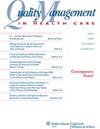Hospital Unit Type and Professional Roles as a Predictor of Relational Coordination in an Army Medical Center.
IF 1.2
4区 医学
Q4 HEALTH CARE SCIENCES & SERVICES
引用次数: 0
Abstract
BACKGROUND AND OBJECTIVES High-quality communication and relationships are associated with quality of care. Workflow differences across hospital units can impede communication and relationships among health care professionals. Relational coordination (RC) is a process of communication supported by shared goals, shared knowledge, and mutual respect and is associated with quality of care and better performance outcomes in civilian hospitals. However, RC has not been explored in military hospitals. The objective of our study was to determine whether RC differs between hospital units and professional roles. Specifically, we examined RC differences by unit type for nurses, resident physicians, and physicians working in an Army Medical Center. METHODS We conducted an exploratory analysis of a secondary question from a cross-sectional study using a convenience sample of active-duty and civilian licensed practical nurses (LPNs), registered nurses (RNs), physician residents, and physicians (n = 289). We received institutional review board approval from the study site. Data were collected from January 2020 to March 2020, and participants completed a 47-item survey regarding their experiences of RC in various hospital units. We used t tests and one-way analyses of variance to explore bivariate relationships between RC and other study variables, as well as multiple regression to explore whether RC varied by unit type. We controlled for education and experience by including them in the model because these variables may influence perceptions of nurse-physician RC and their interactions with each other. RESULTS Seventy percent of participants were civilian (n = 203), 75% RNs (n = 217), and 78% female (n = 216). The mean age of respondents was 40 years (SD = 11.7), and the mean experience level was 11.9 years (SD = 9.5). RC was not associated with unit type. Total RC and between-role RC were associated with professional role. Physicians reported higher RC (β = .45, P = .01), and LPNs reported lower RC (β = -.06, P = .01). Education and experience were associated with RC. Participants with less experience reported higher RC (β = -.01, P = .00), and participants with graduate degrees reported lower RC (β = -.62, P = .00). CONCLUSIONS We recommend hospital leaders consider interventions to build interprofessional relationships, including interdisciplinary meetings, huddles, and structured communication tools. Improving RC among health care professionals is a cost-effective and unique way to enhance communication and collaboration among health care professionals across hospital units.医院单位类型和专业角色是陆军医疗中心关系协调的预测因素。
背景和目的高质量的沟通和关系与护理质量息息相关。医院各科室之间的工作流程差异会阻碍医护人员之间的沟通和关系。关系协调(RC)是一种由共同目标、共同知识和相互尊重所支持的沟通过程,与民用医院的护理质量和更好的绩效结果有关。然而,关系协调在军队医院中尚未得到探讨。我们研究的目的是确定 RC 在医院单位和专业角色之间是否存在差异。具体来说,我们研究了在陆军医疗中心工作的护士、住院医师和医师在不同单位类型中的 RC 差异。方法我们对一项横断面研究中的次要问题进行了探索性分析,使用的样本包括现役和文职执业护士 (LPN)、注册护士 (RN)、住院医师和医师(n = 289)。我们获得了研究机构审查委员会的批准。数据收集时间为 2020 年 1 月至 2020 年 3 月,参与者填写了一份包含 47 个项目的调查问卷,内容涉及他们在不同医院单位的 RC 体验。我们使用 t 检验和单因素方差分析来探讨 RC 与其他研究变量之间的双变量关系,并使用多元回归来探讨 RC 是否因单位类型而异。我们将教育程度和工作经验纳入模型进行控制,因为这些变量可能会影响人们对护士-医生 RC 的看法以及他们之间的互动。受访者的平均年龄为 40 岁(SD = 11.7),平均工作经验为 11.9 年(SD = 9.5)。RC 与单位类型无关。总 RC 和角色间 RC 与专业角色相关。医生报告的 RC 较高(β = .45,P = .01),LPN 报告的 RC 较低(β = -.06,P = .01)。学历和经验与 RC 有关。经验较少的参与者报告的 RC 较高(β = -.01,P = .00),而拥有研究生学位的参与者报告的 RC 较低(β = -.62,P = .00)。改善医护专业人员之间的 RC 是加强医院各单位医护专业人员之间沟通与协作的一种具有成本效益的独特方法。
本文章由计算机程序翻译,如有差异,请以英文原文为准。
求助全文
约1分钟内获得全文
求助全文
来源期刊

Quality Management in Health Care
HEALTH CARE SCIENCES & SERVICES-
CiteScore
1.90
自引率
8.30%
发文量
108
期刊介绍:
Quality Management in Health Care (QMHC) is a peer-reviewed journal that provides a forum for our readers to explore the theoretical, technical, and strategic elements of health care quality management. The journal''s primary focus is on organizational structure and processes as these affect the quality of care and patient outcomes. In particular, it:
-Builds knowledge about the application of statistical tools, control charts, benchmarking, and other devices used in the ongoing monitoring and evaluation of care and of patient outcomes;
-Encourages research in and evaluation of the results of various organizational strategies designed to bring about quantifiable improvements in patient outcomes;
-Fosters the application of quality management science to patient care processes and clinical decision-making;
-Fosters cooperation and communication among health care providers, payers and regulators in their efforts to improve the quality of patient outcomes;
-Explores links among the various clinical, technical, administrative, and managerial disciplines involved in patient care, as well as the role and responsibilities of organizational governance in ongoing quality management.
 求助内容:
求助内容: 应助结果提醒方式:
应助结果提醒方式:


